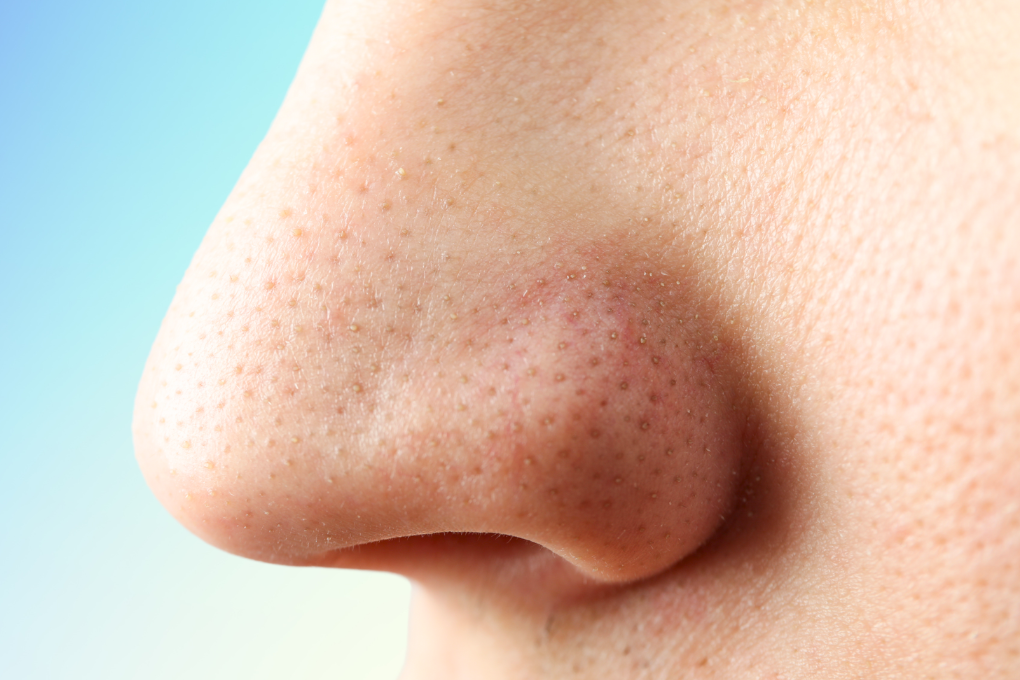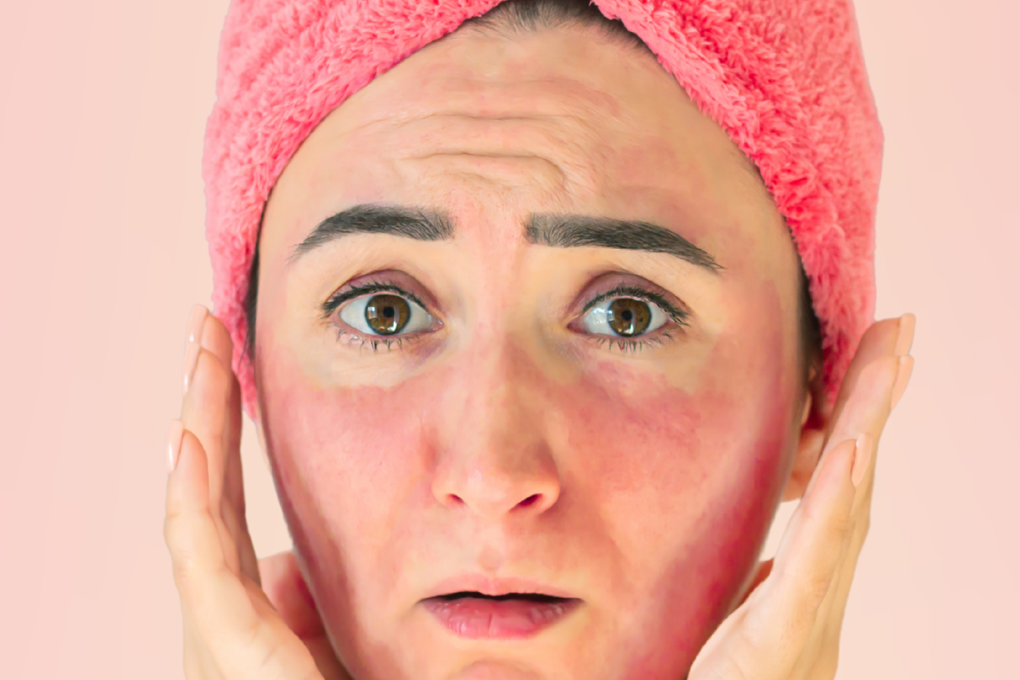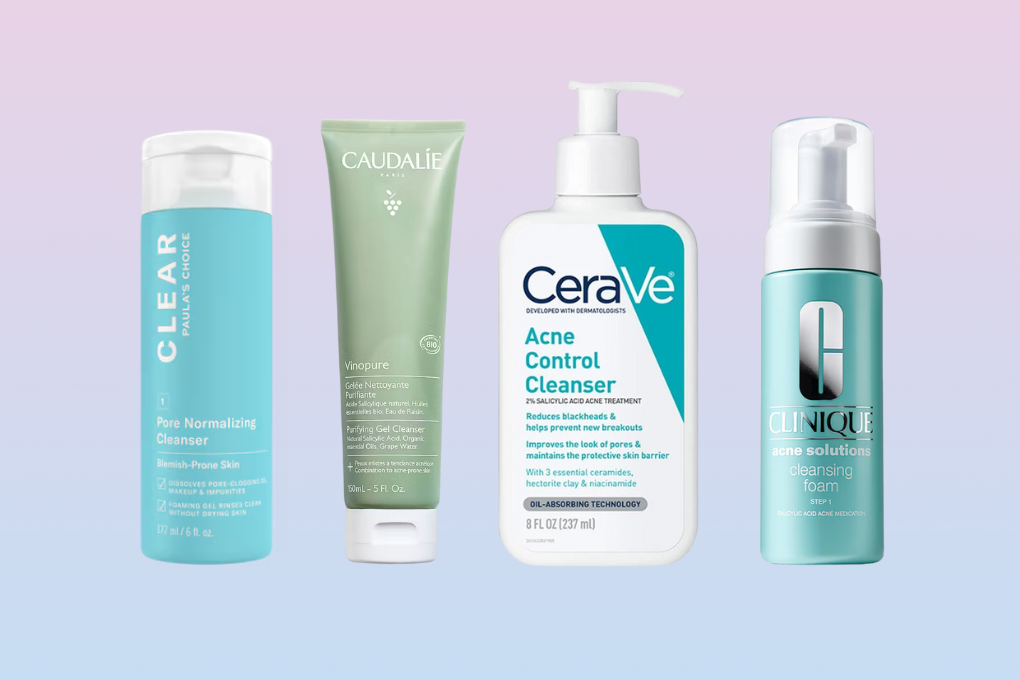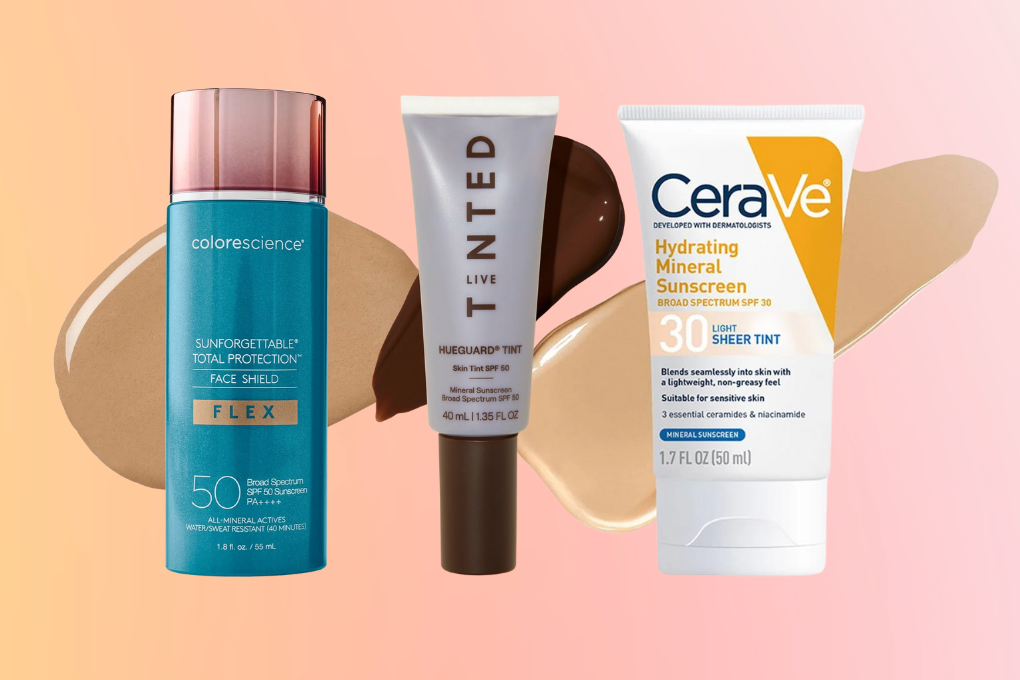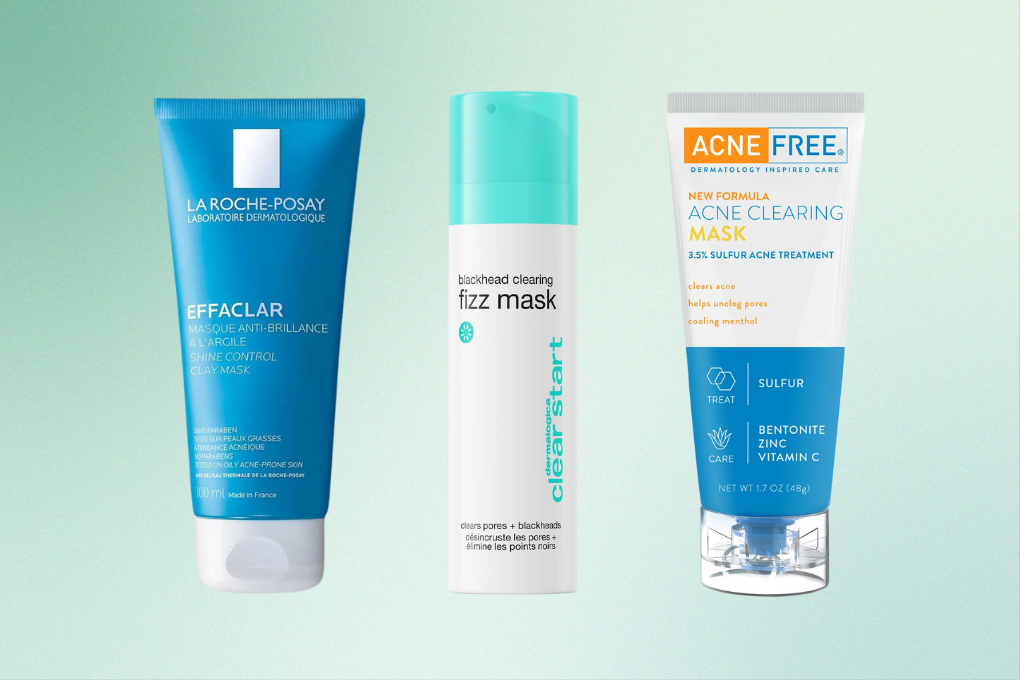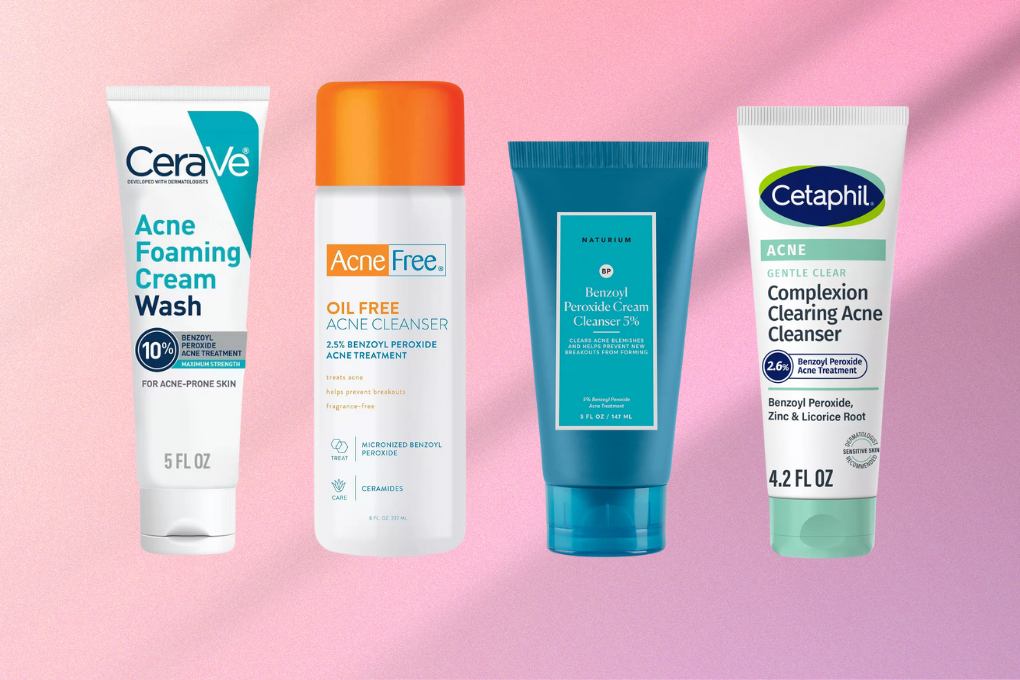Those of us who have oily or acne-prone skin may be quick to assume that every small dark dot in our pores is a blackhead that needs to be removed.
While our pores can be filled with sebum plugs or blackheads, they can also contain sebaceous filaments. Although sebaceous filaments may look similar to blackheads, they are a normal part of our skin and have a job to help it function.
What Are Sebaceous Filaments?
Sebaceous filaments are tiny, hair-like structures located within the pores that often look like tiny gray or dark dots on the skin. If you were to squeeze one, what comes out usually appears as a thin, white to yellowish oily substance that can look like a tiny worm.
Sebaceous filaments have an important but often misunderstood role in helping to transport sebum, the skin’s natural oil, from the sebaceous glands in the pores to the surface of the skin. They line the pore and channel the sebum to the outside of your skin, keeping your skin moisturized and helping to maintain a healthy skin barrier.
Sebaceous filaments are a common and natural feature of our skin, particularly in areas like the nose, chin, and forehead, all hotspots for oil production. Because they are found where there is more oil, it leads to a misconception that sebaceous filaments are a sign of unclean skin, but they show that your skin is working to keep its surface naturally moisturized and healthy.
Sebaceous Filaments vs Blackheads
Sebaceous filaments often appear as small, grayish or yellowish dots, and yes, they can bear a striking resemblance to blackheads. However, while blackheads are a form of acne characterized by oxidized, clogged pores that appear as darkened bumps, sebaceous filaments have a role in oil regulation rather than obstruction.
Because of their role in oil transport, sebaceous filaments are more prominent in oily areas, so they can often show up side by side with blackheads, which are also more common where there is more oil.
How to Get Rid of Sebaceous Filaments?
While the urge to extract them might be strong, it’s important to hold back. Overzealous squeezing or picking can lead to skin damage, irritation, or even scarring.
Unlike blackheads, sebaceous filaments will refill quickly within 30 days because of the ongoing production of sebum, making extraction a temporary and potentially harmful solution. While sebaceous filaments cannot (and should not) be permanently removed, their appearance can be minimized through proper skincare.
Sebaceous Filaments Treatment
If you are concerned about the appearance of sebaceous filaments, there are a few things you can do to make them less noticeable:
Cleanse
Cleanse your skin regularly with a gentle cleanser. This will help to remove excess sebum and dead skin cells from your pores, minimizing the appearance of sebaceous filaments.
Using a cleanser with sulfur, clay, or salicylic acid on the areas with sebaceous filaments can also help control sebum.
Kate Somerville EradiKate Daily Foaming Cleanser Acne Treatment with 3% Sulfur
Kate Somerville's EradiKate Daily Foaming Cleanser contains 3% sulfur to fight breakouts while still being gentle enough to use on a daily basis. This whipped sulfur foaming cleanser keeps pores clear and absorbs excess oil without overdrying. It is lightly fragranced to offset the sulfur smell. Massage onto skin for 30 seconds and even let it sit for 2-3 minutes on your T-zone as a mask before rinsing to help clear sebaceous filaments.
- 3% sulfur fights breakouts without overdrying
- Can also be used as a mask to clear sebaceous filaments
- Contains fragrance
- Expensive
CeraVe Acne Control Cleanser with 2% Salicylic Acid, Niacinamide, Ceramides, and Oil Absorbing Clay
The Acne Control Cleanser from CeraVe is a gel-to-foam cleanser formulated with 2% salicylic acid, which can exfoliate dead skin cells and penetrate the oil in pores. It also contains oil-absorbing hectorite clay, which, together with the salicylic acid can clear blackheads, unclog and improve the appearance of pores, and prevent future breakouts. Niacinamide, ceramides, and glycerin help to strengthen and support the skin barrier.
- Great value for larger size
- Clay to absorb excess oil
- Ceramides to support skin barrier
- May be too drying for some skin types
Exfoliate
Use a gentle chemical exfoliant such as salicylic acid. This will help to dissolve oil and dead skin cells from the surface of your skin and make your pores appear smaller and sebaceous filaments less prominent.
The Ordinary Salicylic Acid 2% Solution, Acne-Fighting Serum for Blemish-Prone Skin
The Ordinary's Salicylic Acid 2% Solution is an affordable serum that's specially formulated to target acne and allow skin to heal. Its simple, water-based formula in a dropper bottle is easy to apply and contains salicylic acid to exfoliate dead skin cells on the surface of the skin and keep pores clear to prevent future breakouts. This serum can be applied as a targeted treatment to areas with blackheads and clogged pores. It can also help reduce redness and skin texture.
- Great value
- Light water-serum texture
- Small amount
Paulas Choice Skin Perfecting BHA Liquid Exfoliant with 2% Salicylic Acid
Paula's Choice 2% BHA Liquid Exfoliant is a fan favorite for good reason. This lightweight toner refreshes skin and uses 2% strength of salicylic acid to exfoliate and clear pores. It has an optimal pH, which is important for exfoliants to get maximum effectiveness without irritation, and it contains soothing green tea to support the skin’s barrier. But watch out because this gentle formula is still strong, so remember to ease into use.
- Optimal pH for acid
- Green tea to soothe and support skin barrier
- Expensive
- Too strong for some skin types
REN Clean Skincare Ready Steady Glow Daily Tonic with Lactic Acid and Salicylic Acid
Ready Steady Glow Tonic by Ren Skincare contains the best of both worlds, with both lactic acid and salicylic acid in its formula. Lactic acid helps remove dead skin cells from the surface to smooth, while salicylic acid can penetrate oil to help clear pores. This dual approach is a great option if you have oily skin and blackheads, but would also like to address skin texture and tone. Additionally, azelaic acid precursors help brighten skin and fade hyperpigmentation.
- Lactic acid smooths texture
- Salicylic acid helps keep pores clear
- Azelaic acid precursors help even skin tone
- Contains fragrance
- Citrus oils may be irritating for some skin types
Oil Control
If you have oily skin, using products formulated to control oil production can help by reducing the amount of excess sebum in the pores that can accentuate sebaceous filaments.
Murad Oil & Pore Control Lightweight Facial Moisturizer and Pore Mattifier SPF 45
If you find that sunscreens make your face look shiny and greasy, Murad's Oil and Pore Control might be the right fit for your skin. It's a lightweight chemical sunscreen that uses oil-trapping microspheres to help mattify your skin and minimize the look of pores. These mattifying properties give 10 hours of shine control, which can make it an effective primer for makeup. Additionally, it also doubles as a moisturizer, so you can moisturize, protect, and mattify all in one step.
- Oil-trapping microspheres mattify
- Can be used as primer
- Not water-resistant
No Picking
Avoid picking or squeezing your pores. This can damage the skin and potentially lead to scarring or enlarged pores, which can make sebaceous filaments more noticeable.
Prescription Treatments
If you are still concerned about your sebaceous filaments, you can talk to a dermatologist. They may recommend a prescription topical treatment, such as a retinoid, to help reduce the appearance of sebaceous filaments.
Sebaceous Filaments on Nose
Sebaceous filaments on the nose can be extra noticeable, mainly because our noses typically have larger pores and more active oil glands. This makes sebaceous filaments more visible, appearing as small, gray or yellowish dots in the pores.
While it can be tempting to start squeezing at your nose, you’ll have to resist. Overdoing it with extractions or harsh treatments can potentially irritate or damage the skin on your nose or cause broken capillaries, which can only be removed by professional treatment. These filaments are there for a reason, and if you remove them, they will just quickly refill.
Embrace gentle skin care practices and put aside the magnifying mirror. Regular cleansing, light exfoliation, and controlling excess sebum can help keep your nose looking clear and healthy without going overboard. You can occasionally use a clay mask or a hydrocolloid nose patch to absorb excess oil on your nose when you need a quick fix.
Murad Rapid Relief Acne Clay Face Mask with Salicylic Acid and 5% Sulfur
The Rapid Acne Relief mask by Murad is made with 5% bacteria-fighting sulfur as well as exfoliating salicylic acid to tackle breakouts. Kaolin clay, which works to absorb excess oil and reduce shine, is balanced with hydrating Austrian peat extract to keep the mask from being too drying. The smell of sulfur is partially covered by eucalyptus oil, so you get the acne-fighting power with a spa night friendly scent.
- 5% sulfur fights breakouts
- Salicylic acid clears pores
- Kaolin clay absorbs excess oil
- Expensive for the size
La Roche-Posay Effaclar Gentle Purifying Clay Face Mask for Oily Skin Controls Shine
Roche Posay's Effaclar mask for oily skin is designed as a 2-in-1 product that is both a purifying clay mask and shine control. This mask uses kaolin clay and salicylic acid to absorb impurities and excess oil, and also mattifies the skin to reduce shine. The addition of glycerin helps to keep it from being too drying. If you struggle with oily skin, this mask would be a great option on days when you want a more matte look.
- Clay controls excess oil
- Mattifies skin to reduce shine
- Contains fragrance
In the age of impossibly smooth-skinned filters on social media, sebaceous filaments might feel like imperfections when you look at them up close in the mirror. But remember that they are not a skin problem. They are just a normal feature of healthy skin, especially for oilier skin types, helping to transport and regulate sebum. They remind us that the best skincare approach is one that respects and supports our skin’s natural processes.





